21-26 Dec 2013. At the end of the second day of our overland journey through the High Desert and altiplano of Bolivia we were delivered to a hotel sitting on the edge of the great Salar de Uyuni (salt of Uyuni).
The hotel stands alone about 20 km outside of the town. It is made almost entirely of bricks of salt. Even some of the furniture is made of salt. It has two long wings stretching off on either side from the reception area. The rooms face the back. Facing towards the salt flats, are many small seating nooks with big windows, including a nook with hammocks. Through the windows is a view of salt going on forever, and at the edge, by chance, a herd of foraging vicuñas. It is a luxurious hotel, warm, spacious, comfortable, attractive, and certainly unique. The only thing we didn’t like was the salt floor – kinda gritty underfoot.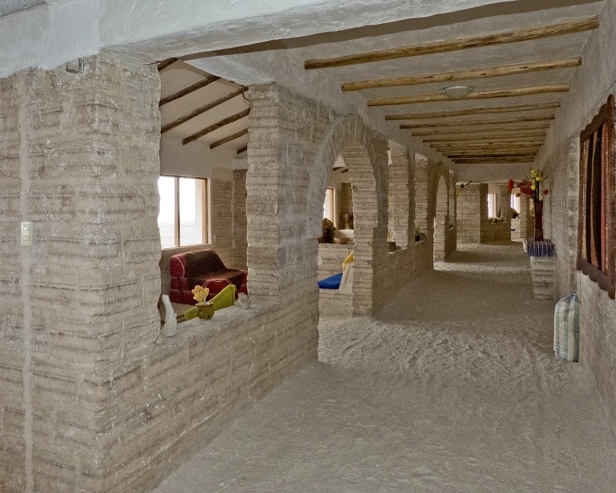

The Salar de Uyuni, part of the altiplano, or high plain, is one of the biggest salt flats in the world. It is 3600 metres (almost 12,000 ft) above sea level and covers an area of 10,500 sq km. It is bigger than some countries. In the centre the salt is 110 metres deep. That’s a huge amount of salt. Unfathomable really. There are about 72 islands in this ‘lake’ of salt, and about 20 communities along its ‘shores’.
We awoke to a downpour. It didn’t look good. Driving to one of the islands in the centre would be impossible if there was too much water on the salt. We set out anyway, and I think with the help of the radiophone Wilson established that the centre of the Salar was dry. This proved to be the case. We drove through a thin skim of water. The further we drove into the centre the drier it became. After the early morning downpour it was dry and sunny all day. The sun is fierce there, being reflected off the blinding white salt at that thin-air altitude. It is quite amazing. Salt as far as the eye can see, with the hazy mountains in the distance forming a rim around it.
We drove to the island of Incahuasi, located more or less in the middle. It is covered in astonishing cacti that grow only one centimeter per year. Some of the taller ones are nine hundred or a thousand years old.
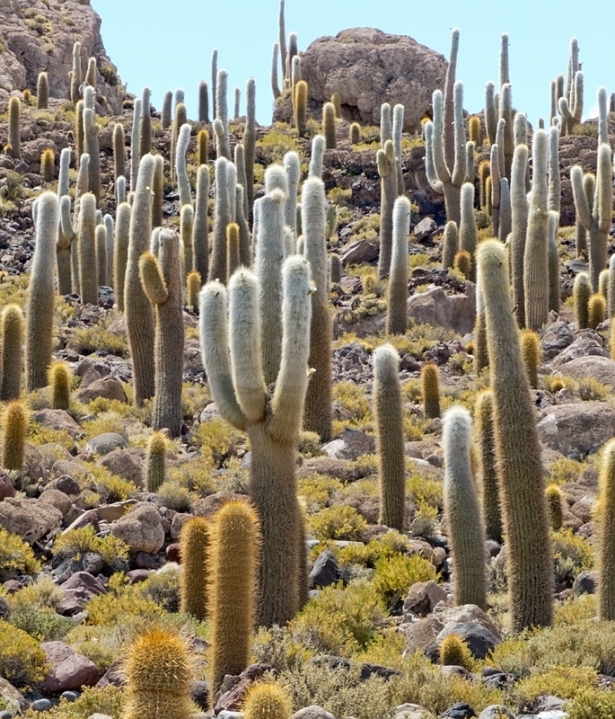

On the island we climbed to the top. Finally we had adjusted to the altitude enough to actually tackle climbing a hill! We met some wonderful Aussies and a Peruvian woman (married to one of the Aussies) on the way down, had a long conversation, ran into them again later in town, and ended up having dinner with them. But back to the salt flats: once again Juan and Wilson pulled an excellent lunch from the back of the Landcruiser. We ate on the island. These people, on the other hand, preferred to eat out in the middle of the ‘lake’.
Sometimes I feel like a child, and Don is a hero and takes care of me.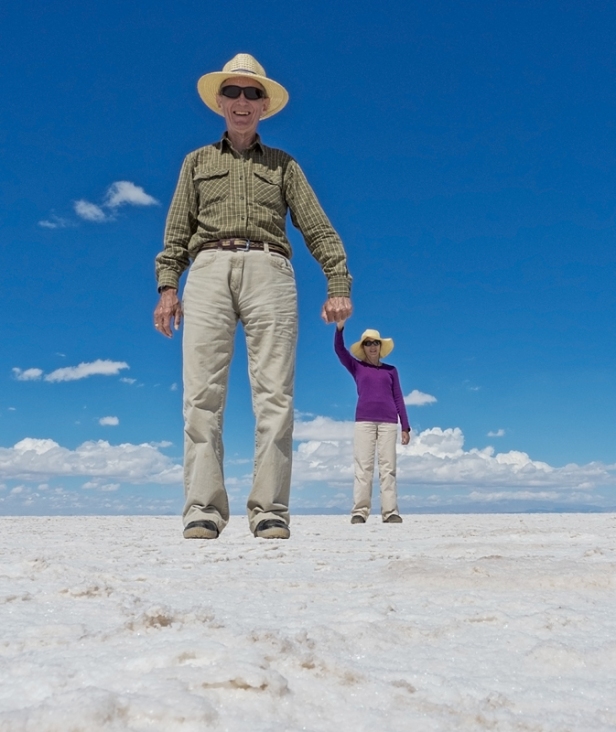
And sometimes I get mad and Don just better take care 🙂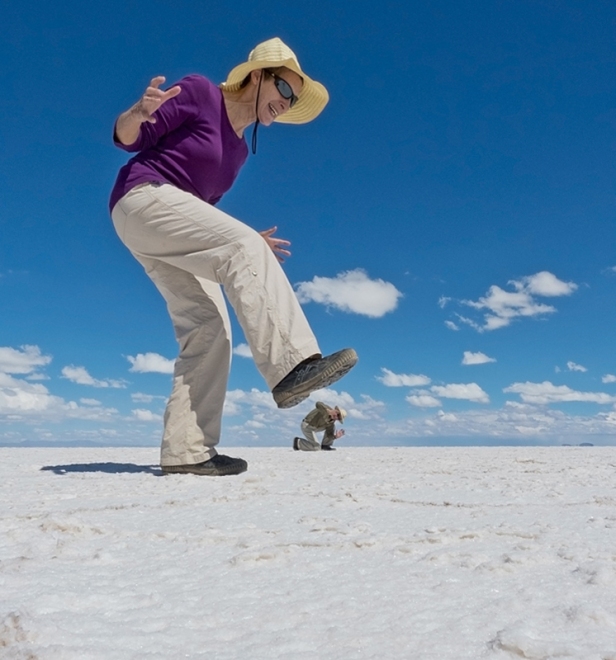
At the edge of the Salar, even close to the end of the day, there was still water on the salt.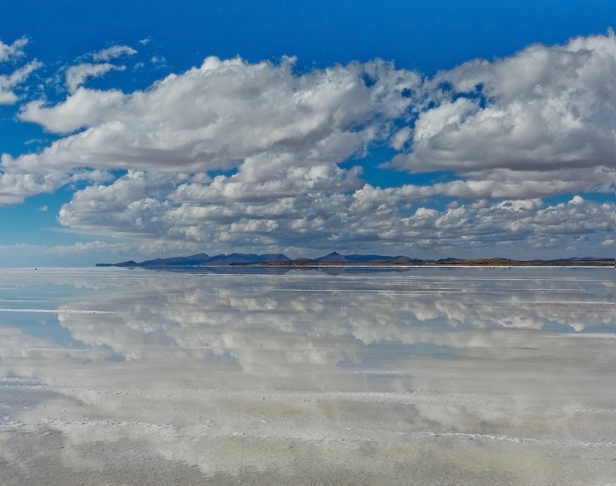
Mounds of salt awaiting harvesting.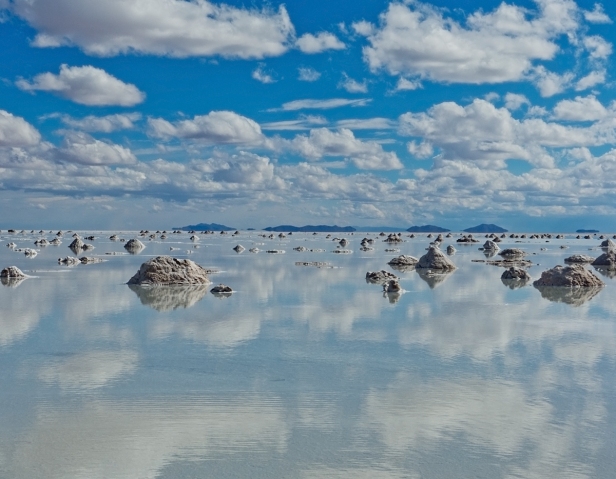
Since Best day ever! had been our declaration at the end of each day of this tour, we finished it with Mejor tour en todo tiempo! I think my Spanish was good enough for Wilson to understand what I meant: best tour ever! We thanked them warmly and said our goodbyes as they left us at our hotel in Uyuni with enough time to check-in, leave our bags, and go explore the local market. It was our first encounter with the bowler-hatted women of Bolivia.
We have observed in many countries that the men, for the most part, have given up on traditional dress, but that the women have not. I could make some guesses as to why this would be so, but since I’m not an anthropologist, they would only be guesses. And I don’t think it’s going to last more than another generation or two. More and more we see the young women in regular western clothes. But for now the women of Bolivia are the same as the women in most countries we’ve been to. Most of them still wear some version of the traditional dress of their area, and hats have a lot to say about where you’re from.
Apparently in the 1920’s there was a shipment of bowler hats from London to Bolivia for the British railway workers. The hats proved to be too small, or the wrong colour, or something or other, so they were tarted up a bit with tassels and marketed to women. It was not the upper class women however who took the bait. The women who embraced this new fashion were the Aymara and Quechua women who had recently migrated to the big city of La Paz. From there the fashion spread among both the Quechua and Aymara women of Bolivia and southern Peru, and, so I’ve read on the Internet where we know everything is true, as far north as the indigenous women of Ecuador. Either way it is lovely for me to be able to google “bowler hats in Bolivia” and get some answers. I remember when I last visited these parts, before the Internet existed, I was greatly intrigued and puzzled by it all. Why are they wearing bowler hats? It was so incongruous. I thought it was strange. And absurd. Now I find it delightful. Flat shoes, alpaca leg warmers, full flowing skirts, a blouse and sweater, a wide thick shawl, and a bowler hat. Why not?! It takes a lot of practice, and a special elegance to balance a bowler hat on the top of your head.
There’s a quite modern and comfortable bus that goes from Uyuni to La Paz. We thought of taking it until we discovered it travels overnight on unpaved roads. That sounded just a bit too uncomfortable, and we wouldn’t be able to see anything anyway, so we flew to La Paz, took a taxi to the bus station and boarded a bus for Copacabana.
At the bus station
From the front seat of the bus waiting to leave La Paz. A long conversation on her cell phone.
My city is changing.
Copacabana, the original Copacabana, on the shores of Lake Titicaca, is a small resort town frequented by both the people of La Paz and foreign tourists. No doubt the people of La Paz come here for vacations by the water, and because it has great spiritual significance for Bolivia. Many Bolivians make a pilgrimage to Copacabana. The tourists come to see the famous Lake Titicaca, the highest navigable lake in the world, and to maybe take a hike on Isla del Sol. But they come mainly because it is a convenient stop on the way south from the Sacred Valley of Peru, with its grand Inca ruins, to the Bolivian altiplano and the “don’t-miss” Salar de Uyuni. We arrived in Copacabana two days before Christmas and checked into the freezing-hell-hole hotel with its lack of heat and erratic power supply, but that’s a story that’s already been told. Copacabana itself is a lively and interesting town, especially on Christmas Day.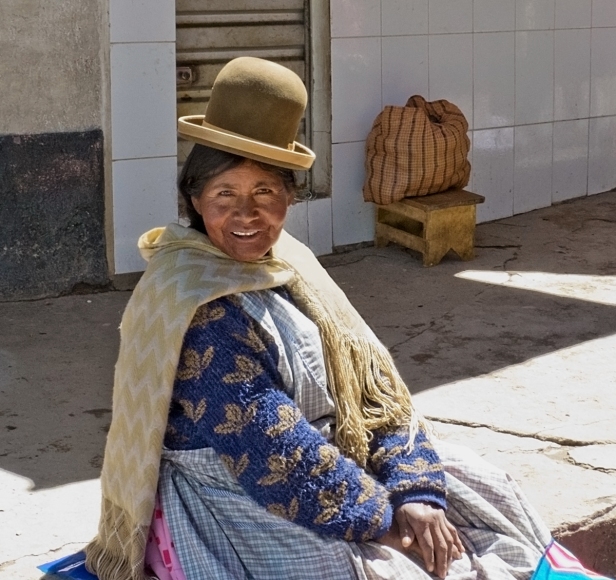
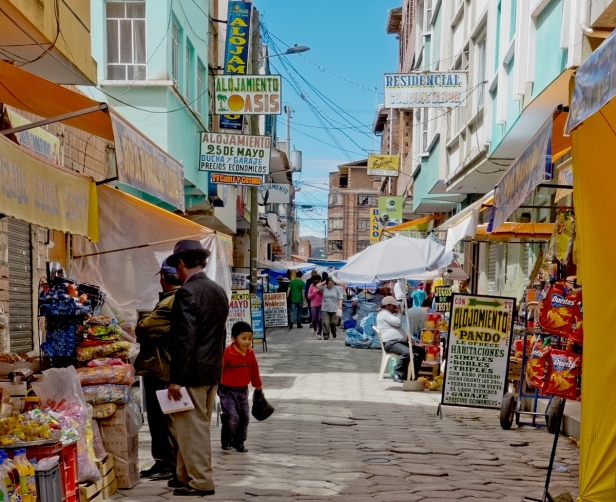
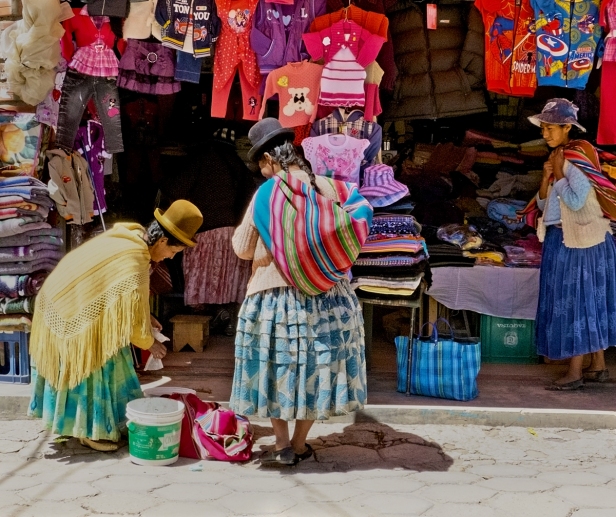
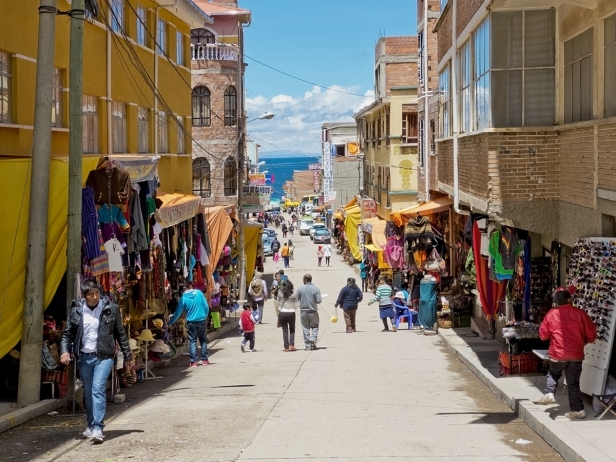

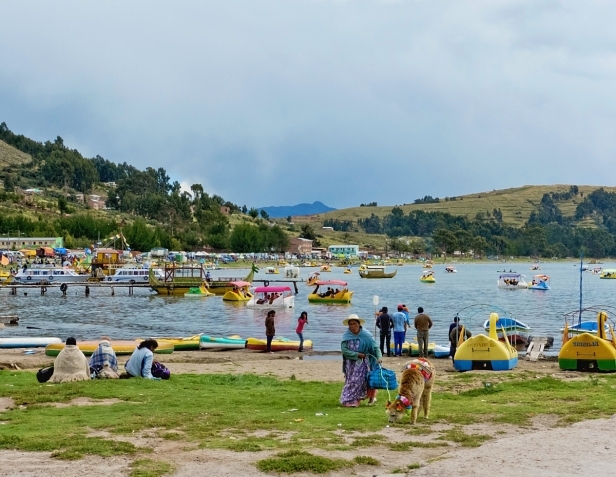

On Christmas day there’s chaos around the church. People decorate their cars and bring them to the church to be blessed by the “dark” Virgin of Copacabana, the patron saint of Bolivia. She is said to be a miracle worker who saved some fishermen from a storm on the lake way back when. The priest blesses the cars with beer, and firecrackers are let off. The beer and firecrackers hark back to the original sacred practices of the indigenous people of the region and their worship of Pachamama, the Earth Goddess. Thus we have an example of the perfect blend of indigenous sacred practice and Roman Catholicism that is seen throughout Latin America. It’s a madhouse, an endless traffic jam, a complete zoo, a street party.
Everyone is dressed in their finest clothes. I was drawn by this woman’s beautiful shawl and photographed her as she walked towards us. As she neared my “Muy bonita!” (very beautiful!) brought a huge smile.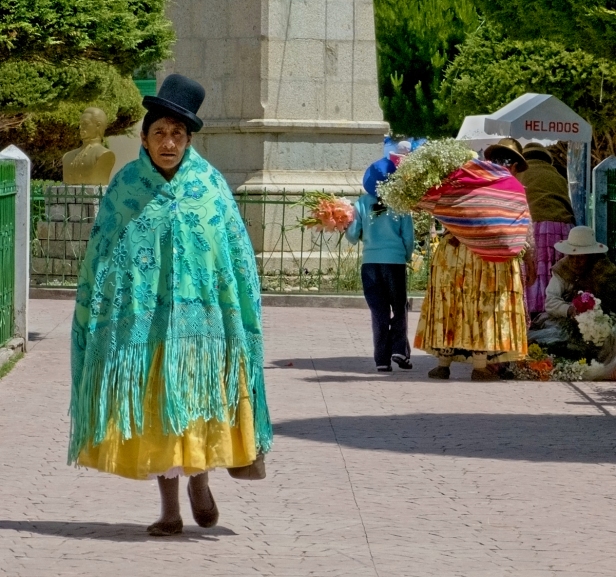
And the cars are dressed in flowers, Christmas decorations and party hats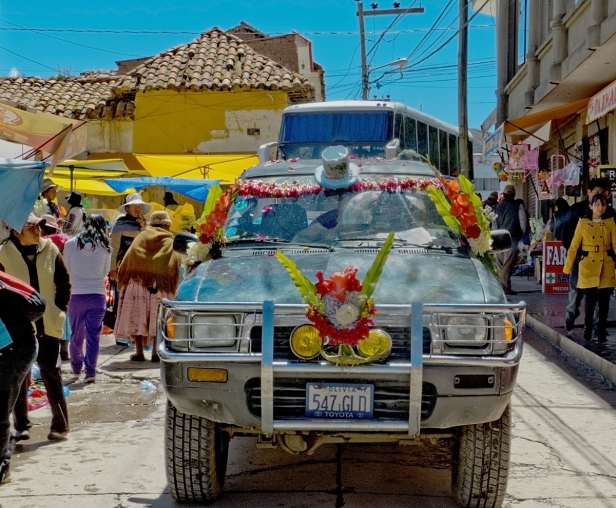
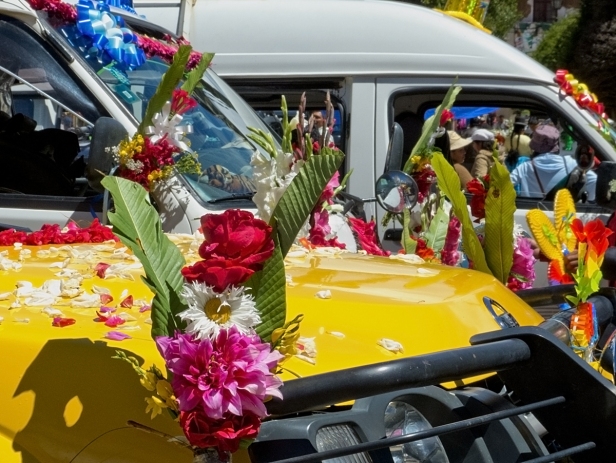
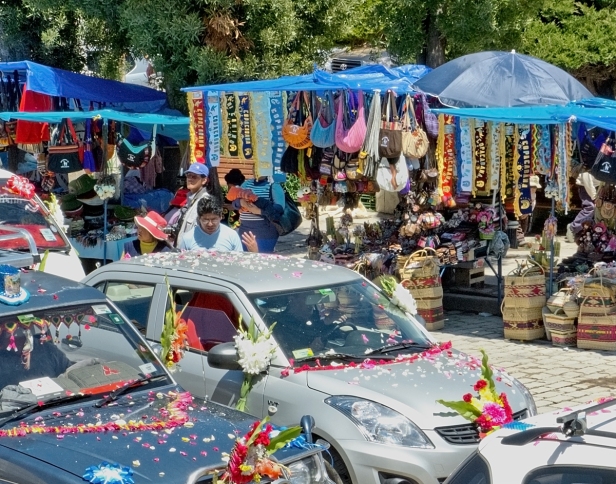
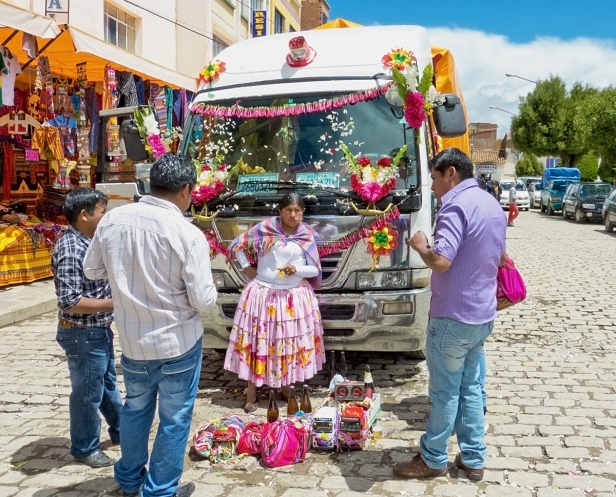
Look what I got for Christmas

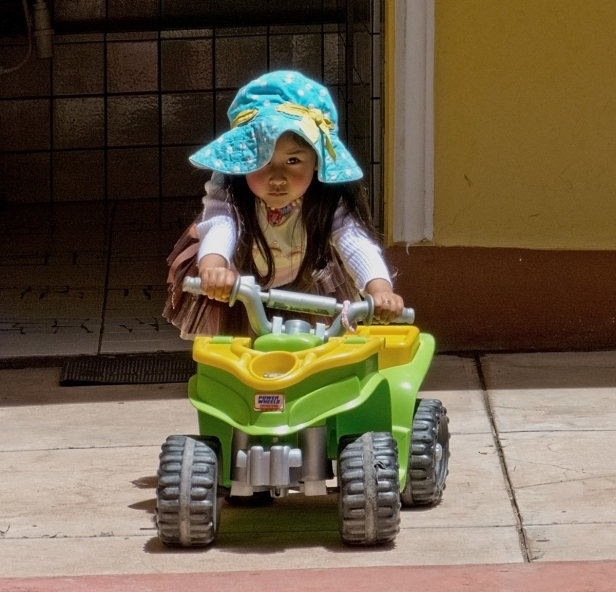
Next blog post: We did go for a hike on Isla del Sol, the sacred birthplace of the Incas, and then travelled by bus to Puno, Peru for more explorations on Lake Titicaca.
If you’re intrigued enough to want to know more about the Virgin of Copacabana, and cars with hats, check out this excellent article on Donna Yates’ blog. And if you want to read more about the history and fashion of bowler hats in Bolivia there’s an very good article here.
All words and images by Alison Louise Armstrong unless otherwise noted.
© Alison Louise Armstrong and Adventures in Wonderland – a pilgrimage of the heart, 2010-2015.

great shot sir….
LikeLike
Thank you!
LikeLike
Reblogged this on ALLKNOL and commented:
Salt Flats and Bowler Hats: Uyuni and Copacabana, Bolivia
LikeLike
Thank you so much for reblogging. Much appreciated. And thank you so much for following. I hope you enjoy the stories of our journey. Cheers, Alison
LikeLike
Beautiful pictures and culture! Loved this blog a lot. Thanks 🙂
LikeLike
Thanks Janei. So glad you’re enjoying it. My pleasure.
LikeLike
I love your wonderful photos ! Looks like an amazing place, must put it on my list of places to explore. I have just returned from Java the home of batik. My blog is marinaelphick.com.
LikeLike
Thank you so much Marina. Bolivia is an amazing place. Don’t know if you found it or not but the post called UnBoliviable covers the first 2 days of our journey through the High Desert of Bolivia – just extraordinary! I just had a quick look at your blog (we’re in the Amazon and net speed is slow) and have to say I think your batik work is absolutely exquisite! Very beautiful. You’re so talented!
Thanks for following. I hope you enjoy the stories of our journey. I’ll come back to your blog when we have better net speed. Cheers, Alison
LikeLike
Reblogged this on Mackneen_The Algerian Goldfinch.
LikeLike
Thank you so much! And thank you for the follow. I hope you enjoy the stories of our journey. Cheers, Alison
LikeLike
Wow! What a trip. Thanks to you, I can now scratch Bolivia off my list of places to visit. But seriously, I loved your whimsical pictures and great prose. Very nice post.
LikeLike
Thanks Joe, glad you enjoyed it. I must confess the ‘depth of field’ photos all came from our guide Juan – he was the one who set them up and took them. It was quite a trip. There’s a previous post ‘UnBoliviable’ covering the first 2 days. Don’t scratch it off your list – go do it 🙂
LikeLike
I was in these magical places in 1999. Thank you for reviving the memories with your wonderful recapturing in words in a pictures. What a fantastic place and people.
LikeLike
Thanks Steve. And yes I agree – a fantastic place and people. We felt very lucky to have done this trip.
LikeLike
Those Pictures r incredible and inspiring!!Bon voyage!!
LikeLike
Thanks Natasha. Bolivia was incredible! We’re so glad we went that way. Thanks for following. I hope you enjoy the stories of our journey. I had a quick look at your blog – very cool photos! Cheers, Alison
LikeLike
Thank you so much for the nice comment of my blog!Yes Im sure that I will enjoy the stories after:)) nice to meet you both! Cheers,Natasha
LikeLike
Wow. Wonderful pictures and text. It truly made me want to travel there. Well, I guess I’ll just add it to my list. Thank you.
LikeLike
Thanks Gaia Mouse, thank you so much. Yes do travel there – it’s quite extraordinary. And good luck with your creativity, and your new blog. I love the photo of the feet in the snow. I can almost feel the sensation. And thank you so much for following. I hope you enjoy the stories of our journey. Alison
LikeLike
Reblogged this on briannarepublic and commented:
Ooooooh I like it.
LikeLike
Thanks Brianna, much appreciated. You have some fabulous landscape photos on your blog!
LikeLike
Awww Thank You!
LikeLike
Great pictures, and a view of your world. Many thanks, very inspiring.
thewingsofwonder.wordpress.com Robert McAlpine
LikeLike
Thank you Robert. I glad you enjoyed the post. I had a look at your blog. Your poetry is lovely. I especially loved the ‘Butterfly’ – very evocative.
Cheers, Alison
LikeLike
Cool story 🙂 Brought back nice memories from when I was up there in 2009. I love the Salar and, of course, the indigenous style they still embrace. Enjoyed the read and pics. Here was my take on the Bolivian’s threads and their awesome hats: http://gringowithagreenbag.com/2012/03/31/high-desert-fashion-bolivian-style/
Good travels…Damian
LikeLike
Thanks Damian. Glad you enjoyed the post. I agree Bolivia is a pretty special place. In case you’re interested the post called *UnBoliviable* covers the beginning of our trip through Bolivia. I had a look at your post as best I could (in the Amazon ATM with v slow internet so not all of the pics would open) – very interesting, and great portraits. Love the variety of hats. A local woman in Copacabana described how the women’s hats were specific to their region or village. Good travels to you too. Cheers, Alison
LikeLike
Right on Allison, I will definitely have a read. I think Bolivia is one of the very best places in the world to visit. Wish more people would travel there. So raw and authentic…and stunningly beautiful. The people really make the experience special, as you both know. Thanks again for sharing some of its magic, and fashion 🙂 – Damian
LikeLike
Fascinating post
LikeLike
Thank you. It is certainly a fascinating place. We loved it there.
LikeLike
Hello mates, its wonderful article on the topic of cultureand completely defined, keep it up all the
time.
LikeLike
Thanks Kian, glad you enjoyed it.
Alison
LikeLike
Absolutely fabulous photographs and the colours are a real feast for the eyes! 🙂
LikeLike
Thank you so much!
LikeLike
HEY COOL PIC AND POST IS ALSO VERY NICE!
LikeLike
Thank you so much. And thank you for following. I hope you enjoy the stories of our journey. Lots of great IT info on your site! Namaste, Alison
LikeLike
Excellent photo, gud creativity!
Especially that salt flats! Thanx 4 Showing This!
LikeLike
Thank you very much. I’m glad you enjoyed it. It’s my pleasure to show it.
Alison
(I looked at your blog – I see your are a tech genius!)
LikeLike
Really enjoy ur journey on story@
LikeLike
Thanks 🙂
LikeLike
Reblogged this on the barren page and commented:
Bolivia is on my bucket list. Thanks for posting such wonderful photos. Look forward to following y’alls journey in the future.
LikeLike
Thanks Steve. Much appreciated. In case you missed it, check out this post
https://alisonanddon.wordpress.com/2014/01/20/unboliviable-the-high-desert-and-altiplano-of-bolivia/
It covers the first two day of travel across the High Desert of Bolivia. Cheers, Alison
LikeLike
great shot!
LikeLike
Thanks chudiso.
LikeLike
It feels as if I visited the place myself. I presented things in a very light, informative and intriguing way. I really like! thank you for such a beautiful post. hope to come around your blog more often 🙂
P.S loved the photography too, straight and to the point, some shots are awesome!
LikeLike
Thank you so much Faran, I’m glad you enjoyed it. And thank you for following. I hope you enjoy the stories of our adventures. Cheers, Alison
LikeLike
sorry that was you* presented the things…. Yes sure! and I had to follow. It was too good to ignore 🙂
LikeLike
very well work done…keep going…i liked it…its nice…as am a new blogger in this world and i wrote just 1 blog (story) (http://mindtechnorms.wordpress.com/2014/02/13/when-god-granted-tittus-to-go-to-earth-for-1-day-part-i/) and unable to find my viewer as like you, can u please help me by reading my 1st blog what wrong with my writing…is really something wrong with my writing or am just expecting too early…your helpful comments will really inspire me… and please follow me…
LikeLike
Hello, and thank you for your kind words. I will read your story in the next little while. Unfortunately I don’t have time just now. Commenters have said it is a very good story. I hope this encourages you. I would encourage you to take lessons to improve your English which is quite good but needs some polishing with sentence structure and tenses so it will be easier to follow.
I wish you great good luck in your blogging venture. It takes time to build up an audience. Persevere and be patient. With time everything will improve.
Blessings, Alison
LikeLike
thanks so much for your advice alison…i will take care of ur words and improve myself in tenses…after reading your comment i quickly went to my post and changed the grammatical errors at my best…thanks again…
LikeLike
Absolutely stunning photos! I need to get to South America!!!
Visit New Gen Journo for unbiased opinions on everything
LikeLike
Thanks Elliott. Yes, get yourself to South America – it’s all quite amazing. Check out this post about out journey across the High Desert of Bolivia
https://alisonanddon.wordpress.com/2014/01/20/unboliviable-the-high-desert-and-altiplano-of-bolivia/
I had a look at your excellent New Jen Journo – I’ll be returning for sure. So many interesting articles. Thanks.
LikeLike
ese es mi pais..! hermoso por dondequiera que vayas..!
LikeLike
We translated from the Spanish. Thank you for your kind wishes. We loved Bolivia. These posts are also about your country. I thought you might like to see them.
https://alisonanddon.wordpress.com/2014/01/20/unboliviable-the-high-desert-and-altiplano-of-bolivia/
and https://alisonanddon.wordpress.com/2014/02/22/reeds-rocks-pumas-and-gods-lake-titicaca-bolivia-and-peru/
LikeLike
Reblogged this on Ricjark Vlogs & Games and commented:
una de las muchisimas opciones de turismo cultural por Bolivia
LikeLike
Thank you very much for the reblog.
LikeLike
Those salt flats – how unique and amazing a place to see! By the way, the people of Ecuador dress similarly to the people of Bolivia. As you say, it is more the women, rather than the men, who dress traditionally. Great photos, as always. Loved the little girl on the bicycle.
LikeLike
Thanks Shirley. I also loved that little girl – such determination in her eyes. And, yes, the salt flats are extraordinary. We’ve just arrived in Ecuador. We’re in Quito recovering from a full-on 8 days in the Amazon in Peru. I just had a look at your blog posts on Ecuador – sounds like you had the same kind of Amazon experience. We’re off to the Otavalo Market in a couple of days – should see some traditional dress there – I think it’s an Andean thing regardless of the country borders.
LikeLike
The hotel photos…..incredible! I have never seen anything like that before! I guess a salt floor would feel a little gritty. Rather like sand, but not. 🙂
LikeLike
Isn’t that hotel a wondrous thing? Apparently there are 5 of them scattered around the edge of the salt flats. We were very intrigued by it. And it was very comfortable except for the floor so we just wore shoes. Even the bathroom had a salt floor, but there were mats so that helped.
LikeLike
We just finished our trip to the Salar de Uyuni and like you said, it was an amazing sight. A real highlight. Thank you so much for sharing your adventure and encouraging us to go as well. I’m reading your Peru posts now to see what’s next! 🙂
LikeLike
So much magic comes next 🙂
We didn’t spend time in La Paz, but Lake Titicaca from Copacabana and from Puno was pretty fascinating. I really recommend doing a 2 day home stay on the Uros islands rather than just a half day trip. In our post on Lake Titicaca I linked to a family that did a home stay – I think it will tell you who to contact. Happy travels, Alison
LikeLike
What incredible images! Looked like you just had the most amazing time! Those perspective photos really surprised me at first!
LikeLike
Thank you so much. Yes we did have an amazing time – so much more than we expected. The post called ‘Unboliviable’ is about the first 2 days of the journey. We had no idea how wonderful it was going to be. The perspective photos were taken by our guide Juan – he really knew what he was doing. They’re so clever.
LikeLike
Hi Alison and Don, sometimes i wonder whether i can write a travel blog after gleaning relevant details from blogs similar to yours and taking out images from various sites,i wonder if i plagiarise writing skills of such geniuses like ‘Leslie Charteris’,maybe i will become an immensely popular blogger,after all ‘james hadley chase’created a U.S out of his imagination and even a district called,paradise city, off miami coast,when in fact,chase, never ever lived in U.S.
LikeLike
What a wonderfully rich imagination you have Vivek, however I’d be pleased if you didn’t plagiarize my words or pictures 🙂 Joking. I know you wouldn’t, but your examples (Charteris and Chase) do show what amazing worlds can be created from nothing just with imagination. No plagiarizing necessary. Perhaps you could try creating your own unique scenario.
LikeLike
Love the photos. Hope I can visit the salt flat too.. it looks amazing
LikeLike
Thanks Jade. And thanks for all the ‘likes’. Hope you get to Bolivia one day. It really is amazing.
LikeLike
Another great post, Alison. I lespecially oved the fun photos at the Salt Flats!
LikeLike
Thanks so much Naomi. Glad you enjoyed it. I must tell you though that our guide was entirely responsible for the trick perspective photos. We even have one of Don and me holding up the truck 🙂
LikeLike
Hi! Lovely snaps! Someday, we hope to make a trip to Bolivia. 🙂
LikeLike
Thanks so much. Do try to get to South America – it’s really amazing.
Alison
LikeLiked by 1 person
Beautiful pictures! Thank you so much for sharing! 🙂 Can’t wait to go there someday. What was the name of the Hotel you stayed at?
LikeLike
Thanks so much Hannah. Do go – it’s an amazing place. We stayed at the Hotel Luna Salada.
LikeLike
Ah Salar De Uyuni…. one of my bucket list for life after Macchu Pichu. So how is the price for every day’s stuffs such as meals, transport etc? Is it costly enough?
LikeLike
The usual way to do it is a 3 day overland trip from Uyuni to San Pedro de Atacama in northern Chile. (Or vice versa). It is a journey not to be missed and was one of the highlights of our time in South America. HOWEVER: there are a wide range of tour companies and prices. The cheaper the tour the greater the risk of being in a poorly maintained vehicle. Several tourists were killed a few years ago due to bald tires on the vehicle when the driver lost control on the salt flats. You’ll be travelling with about 16 people and staying in pretty basic hostels, which would probably be fun as long as the vehicle and driver are safe.
We paid a lot of money for a very expensive private tour staying in high-end hotels because we wanted to be safe.
To get to Uyuni you can either fly from La Paz or take the overnight bus (much cheaper of course), and once there food and hostels are not that expensive at all. Then you can pay for a one day tour of the saltflats if you don’t want to do the 3 day tour to Chile.
If you scroll through the comments you’ll find links to other articles about the saltflats and the various tours. Hope this helps.
Alison
LikeLike
Very nice article, I had just shared this article on my travel site, I hope you don’t mind. This is a website that let bloggers or travelers to share some great articles or photos about travel, and indexed by attractions.
I know you love travel and write a lots of blog post about interesting places in the world, so I would like to invite you to be a member of our community and share your blog post, photos or review.
You can check the link below to find your articles on my site, if you don’t want me to share your articles, please tell me, I will remove it as soon as possible.
http://www.travelersfootprint.com/en/attraction-detail/The-Uyuni-Salt-Flat@Bolivia
Hope you all the best =)
Sam
LikeLiked by 1 person
Thank you Sam. I don’t mind at all. It’s a very good idea you have, and your site looks great. I’ll join the community.
Alison
LikeLike
Нay posibilidad de suscribirme a este blog de alguna forma?
LikeLiked by 1 person
Sí. Haga clic en el botón azul que dice “Follow Adventures in Wonderland”.
Arriba a la derecha. Gracias.
Alison
LikeLike
I loved this post. It bought back so many memories for me. Gorgeous photos. You stayed in a much more luxurious place than us in Uyuni. It looks wonderful – even with a salt floor! I have heard the same story re. the bowlers – we must’ve read the same internet piece!
LikeLiked by 1 person
Thanks Tracey, I’m glad you liked it. It was quite special staying in that salt hotel – a really unique experience.
I first went to Bolivia in 1978, long before the internet. I was so puzzled by the bowler hats. They seemed so incongruous. Whoever marketed them to women sure had a good idea.
Alison
LikeLike
Beautiful photos. I really enjoyed reading about and “seeing” your journey through this part of the world. Thank you for sharing.
LikeLiked by 1 person
Thank you so much Lane. That whole trip through Bolivia was truly amazing. I’m glad you enjoyed my retelling of it.
Alison
LikeLiked by 1 person